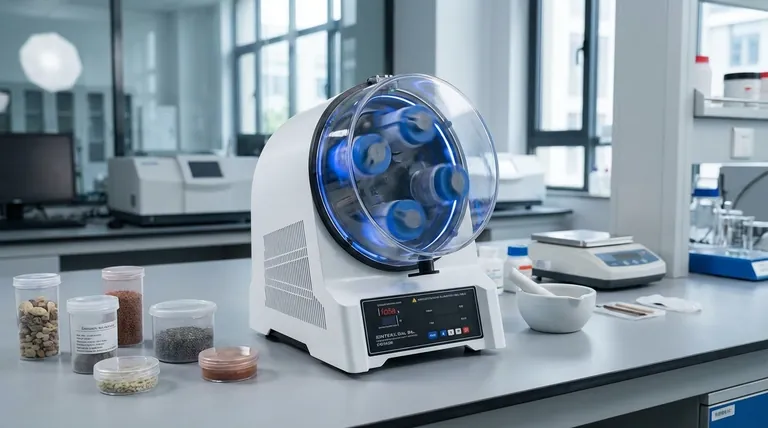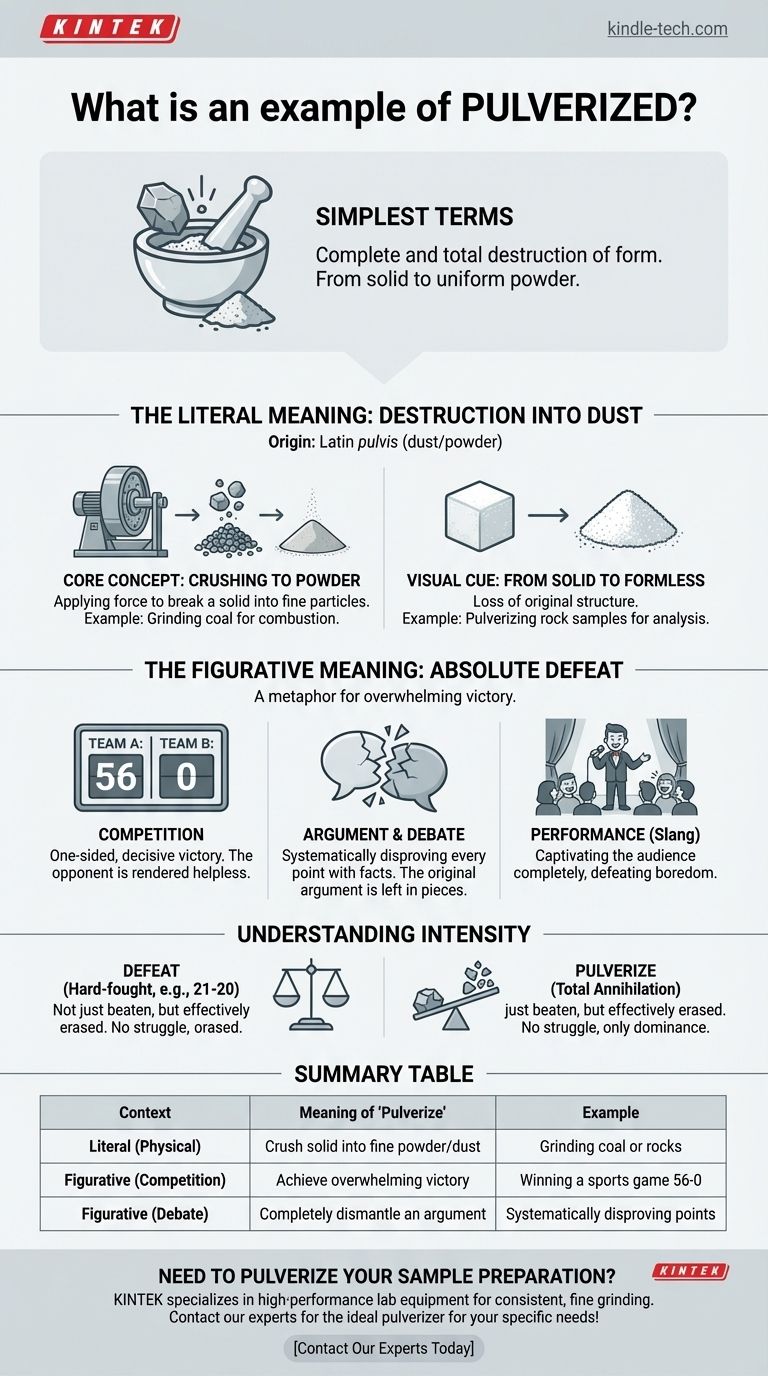In its simplest terms, a classic example of pulverizing something is using a mortar and pestle to crush a solid rock into a fine, uniform powder. The word signifies a complete and total destruction of the original object's form, whether it is a physical item, a competing team, or an opposing argument.
To "pulverize" is to reduce something to its most basic components, leaving no recognizable structure behind. This applies literally to crushing solids into dust and figuratively to achieving a victory so absolute that the opposition is rendered completely helpless.

The Literal Meaning: Destruction into Dust
The origin of "pulverize" comes from the Latin word pulvis, meaning dust or powder. This physical transformation is the core meaning of the word.
The Core Concept: Crushing to Powder
At its heart, to pulverize is to apply force to a solid object until it breaks down into fine particles. Think of a powerful machine grinding large stones into gravel, and then grinding that gravel into sand. The final stage of this process is pulverization.
Examples in Industry and Science
In industrial settings, coal is pulverized into a fine powder before being burned in a power plant to maximize combustion efficiency. Similarly, in geology, rock samples are pulverized so their chemical composition can be accurately analyzed.
The Visual Cue: From Solid to Formless
The key visual is the loss of form. A sugar cube, when pulverized, becomes granulated sugar. A whole coffee bean, when pulverized, becomes fine grounds. The original, singular object is gone, replaced by a mass of tiny particles.
The Figurative Meaning: Absolute Defeat
Beyond the physical, "pulverize" is used as a powerful metaphor to describe an overwhelming and decisive victory where the opposition is completely dismantled.
Application in Competition
This is one of the most common figurative uses. A team doesn't just defeat another team 56-0; they pulverize them. The score reflects a total inability for the losing side to compete, rendering them helpless.
Application in Arguments and Debate
In a debate, a speaker can pulverize their opponent's argument by systematically disproving every single point with facts and logic. The original argument is left in pieces, with no foundation left to stand on.
Application in Performance
As a slang term, it can describe an artist who completely captivates their audience. A comedian who has the audience roaring with laughter for their entire set is said to have pulverized the room. They have defeated any potential for boredom or indifference.
Understanding the Word's Intensity
Using the word "pulverize" is a deliberate choice. It is a word of extremes and should not be used to describe a minor or closely contested event.
It Implies Total Annihilation
To pulverize an opponent means they were not just beaten but were effectively erased from the competition. There was no struggle, no back-and-forth, only complete dominance.
When to Use 'Defeat' vs. 'Pulverize'
A "defeat" can be narrow and hard-fought (e.g., winning a game 21-20). "Pulverize" is reserved for a victory so one-sided it becomes a demolition. Using it for a close contest would be an overstatement.
How to Apply This to Your Vocabulary
- If your primary focus is describing a physical process: Use 'pulverize' when a solid object is mechanically ground down into a fine powder or dust.
- If your primary focus is describing a competition: Use 'pulverize' only when a victory is so lopsided that the opponent was completely overwhelmed and non-competitive.
- If your primary focus is describing a debate: Use 'pulverize' when an argument is so thoroughly dismantled by evidence that no credible counterpoints remain.
Understanding this distinction allows you to use this powerful word with precision and intent.
Summary Table:
| Context | Meaning of 'Pulverize' | Example |
|---|---|---|
| Literal (Physical) | To crush a solid into fine powder/dust | Grinding coal for power plants or rocks for analysis |
| Figurative (Competition) | To achieve an overwhelming, absolute victory | A sports team winning 56-0 |
| Figurative (Debate) | To completely dismantle an argument with facts | Systematically disproving every point in a discussion |
Need to Pulverize Your Sample Preparation?
KINTEK specializes in high-performance lab equipment, including robust pulverizers and mills designed for consistent, fine grinding. Whether you're in geology, chemistry, or materials science, our solutions ensure your samples are processed to perfection for accurate analysis.
Contact our experts today to find the ideal pulverizing equipment for your laboratory's specific needs!
Visual Guide

Related Products
- Laboratory Horizontal Planetary Ball Mill Milling Machine
- High-Energy Omnidirectional Planetary Ball Mill Milling Machine for Laboratory
- High-Energy Omnidirectional Planetary Ball Mill Machine for Laboratory
- High Energy Planetary Ball Mill Milling Machine for Laboratory
- High Energy Planetary Ball Mill Milling Machine for Laboratory
People Also Ask
- What is the principle of planetary ball mill? Achieve Rapid, High-Energy Grinding for Your Materials
- What is a planetary ball mill? Achieve Rapid, High-Energy Grinding for Advanced Materials
- How does a planetary mill work? Harnessing High-Energy Impact for Nano-Grinding
- What are the parameters of a planetary ball mill? Master Speed, Time, and Media for Perfect Grinding
- What is the difference between a ball mill and a planetary mill? Choose the Right Grinding Tool for Your Lab



















